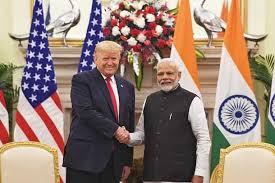In a recent statement that has garnered significant attention, former U.S. President Donald Trump expressed his belief that India will soon lower tariffs on U.S. goods. This remark, made during an interview, signals a potential shift in trade relations between the two countries and suggests that negotiations may be underway to reduce barriers to trade, which could benefit both the U.S. and Indian economies.
Trump’s Optimistic Prediction
Trump, who has long been a vocal advocate for fair trade policies, voiced his optimism about the future of U.S.-India trade ties. He stated, “I believe India will lower tariffs on U.S. goods in the near future. We have seen progress in recent years, and I’m confident that both countries will reach an agreement that is beneficial to all parties involved.” While Trump did not elaborate on the specifics of when or how this change might occur, his statement reflects his hope that the two nations can come to a more balanced and mutually advantageous trade arrangement.
This comment comes at a time when global trade dynamics are shifting, and both countries are looking to strengthen their economic ties. With India emerging as a major global economic player and the U.S. seeking to expand its influence in the Indo-Pacific region, trade negotiations between the two countries are of significant geopolitical importance.
The U.S.-India Trade Relationship
The trade relationship between the United States and India has been a topic of discussion for many years. While the two countries share a strong diplomatic and strategic partnership, trade has often been a point of contention. India has imposed tariffs on a wide range of U.S. goods, including agricultural products, medical devices, and machinery, citing the need to protect its domestic industries.
On the other hand, the U.S. has expressed concerns over these tariffs, arguing that they hinder the flow of goods between the two nations and create an uneven playing field for American businesses. In response, India has repeatedly stated that its tariffs are in line with its economic goals, particularly in protecting domestic agriculture and manufacturing.
In 2019, the U.S. removed India from its Generalized System of Preferences (GSP), a trade program that allowed Indian goods to enter the U.S. duty-free. This move was seen as a retaliatory action over India’s tariff policies. However, both countries have since continued to engage in discussions aimed at resolving these trade issues, with several rounds of trade talks taking place over the years.
Potential for Tariff Reductions
Trump’s comments about India potentially lowering tariffs are in line with broader efforts to enhance trade relations between the two nations. In recent years, both India and the U.S. have signaled their willingness to resolve trade disputes, and the reduction of tariffs on key goods could be one of the outcomes of ongoing negotiations.
For the U.S., reducing tariffs could mean greater access to the rapidly growing Indian market, which has a population of over 1.4 billion people and is becoming an increasingly important consumer base. Sectors such as agriculture, pharmaceuticals, and technology could particularly benefit from lower tariffs, which would make U.S. exports more competitive in India.
For India, reducing tariffs could help stimulate trade and investment, particularly in high-value sectors like manufacturing and technology. A more open trade environment could also foster greater cooperation with the U.S. in areas such as innovation, infrastructure, and supply chains, which would help bolster India's economic growth.
The Strategic Importance of U.S.-India Trade
Trade between the U.S. and India is not just about economic gain but also about strategic alignment. Both countries share concerns about regional security, especially in the Indo-Pacific region, and have increasingly collaborated on defense, technology, and infrastructure. Strengthening their trade relationship could reinforce this broader strategic partnership.
Moreover, with China continuing to assert its influence in the region, both the U.S. and India are keen to maintain a strong, independent economic presence in Asia. By reducing trade barriers, both countries could enhance their economic standing and counterbalance China’s growing dominance in the global marketplace.
Challenges to Overcome
While there is optimism about the potential for tariff reductions, several challenges remain. India’s tariff policies are influenced by a complex mix of domestic political, economic, and social factors, including protecting local industries and ensuring that Indian businesses remain competitive. Any move to lower tariffs would need to be carefully negotiated to address these concerns.
Additionally, the global trade landscape is evolving, with issues such as climate change, technology regulation, and digital trade taking on greater importance. Both countries will need to navigate these new challenges as they work toward an updated trade agreement that aligns with their long-term economic and strategic goals.
Conclusion: A Positive Step for U.S.-India Trade Relations
Trump’s comments about India lowering tariffs on U.S. goods reflect a positive outlook for the future of U.S.-India trade relations. While the specifics of any potential agreement remain unclear, the prospect of reduced trade barriers could provide significant benefits for both economies. As both countries continue to strengthen their partnership in trade, defense, and technology, this potential move toward lowering tariffs could serve as a catalyst for even deeper collaboration.
As the global economic environment continues to evolve, the U.S. and India have a unique opportunity to shape their trade relationship in ways that support mutual growth and secure their standing on the world stage. The outcome of these ongoing discussions will likely play a key role in the economic futures of both nations.

